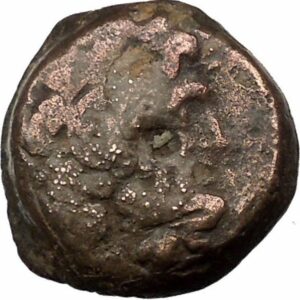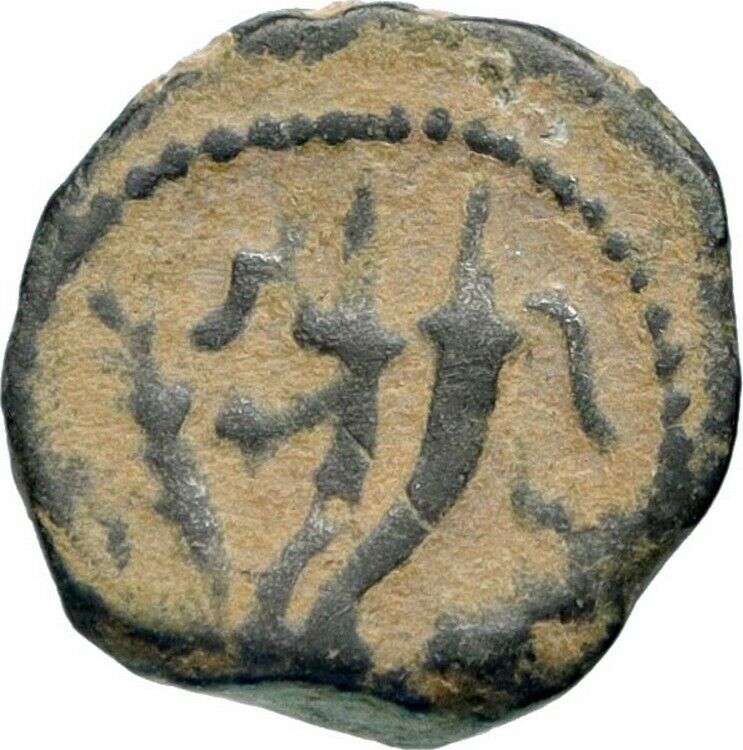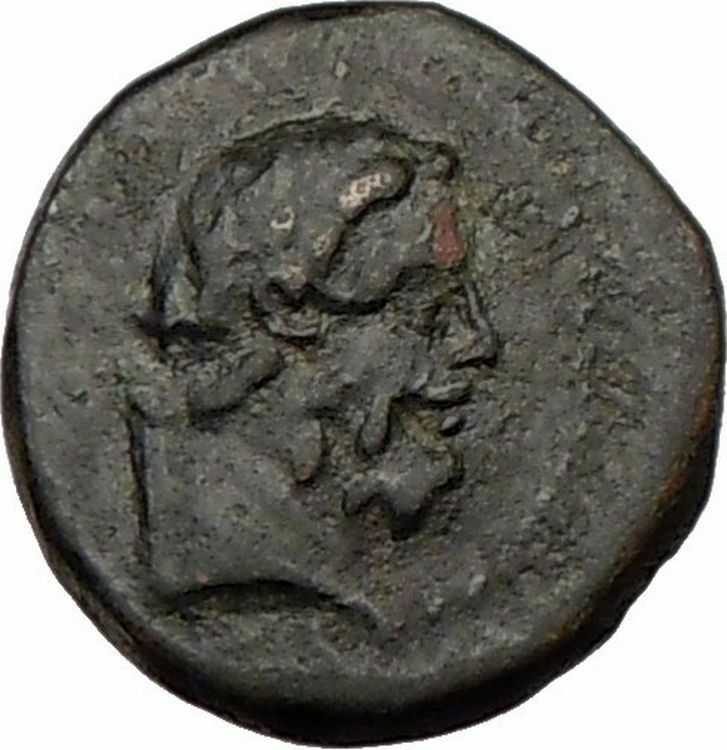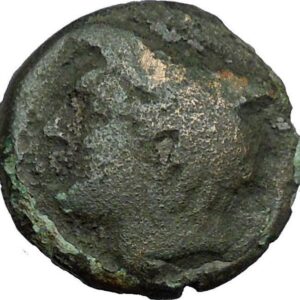|
Greek city of
Miletos in
Ionia
Bronze 16mm (3.75 grams) Struck circa 260-220 B.C. Uncertain magistrate.
Reference: Cf. Deppert Period IV 595-9
Laureate bust of Apollo facing three-quarters left.
Lion standing right, head left; star above, [two monograms to right],
[magistrate’s name] below.
You are bidding on the exact item pictured,
provided with a Certificate of Authenticity and Lifetime Guarantee of
Authenticity.

In
Greek
and
Roman mythology
,
Apollo, is one of the most
important and diverse of the
Olympian deities
. The ideal of the
kouros
(a beardless youth), Apollo has been
variously recognized as a god of light and the sun; truth and prophecy;
archery
; medicine and healing; music, poetry,
and the arts; and more. Apollo is the son of
Zeus and Leto
, and has a
twin
sister, the chaste huntress
Artemis
. Apollo is known in Greek-influenced
Etruscan mythology
as Apulu. Apollo was
worshiped in both
ancient Greek
and
Roman religion
, as well as in the modern
Greco
–Roman
Neopaganism
.
As the patron of Delphi
(Pythian Apollo), Apollo was an
oracular
god — the prophetic deity of the
Delphic Oracle
. Medicine and healing were
associated with Apollo, whether through the god himself or mediated through his
son Asclepius
, yet Apollo was also seen as a god
who could bring ill-health and deadly
plague
as well as one who had the ability to
cure. Amongst the god’s custodial charges, Apollo became associated with
dominion over
colonists
, and as the patron defender of herds
and flocks. As the leader of the
Muses (Apollon Musagetes) and director of their choir, Apollo
functioned as the patron god of music and
poetry
.
Hermes
created the
lyre for him, and the instrument became a common
attribute
of Apollo. Hymns sung to Apollo were
called paeans
.
In Hellenistic times, especially during the third century BCE, as Apollo
Helios he became identified among Greeks with
Helios
,
god of the sun
, and his sister Artemis
similarly equated with
Selene
,
goddess of the moon
. In Latin texts, on the
other hand, Joseph Fontenrose declared himself unable to find any conflation of
Apollo with
Sol
among the
Augustan poets
of the first century, not even
in the conjurations of
Aeneas
and
Latinus
in
Aeneid
XII (161–215). Apollo and Helios/Sol
remained separate beings in literary and mythological texts until the third
century CE.
Miletus (mī lē’ təs) (Ancient
Greek: Μίλητος, literally
transliterated
Milētos,
Latin
Miletus) was an
ancient
city on the western coast of
Anatolia
(in what is now
Aydin Province
, Turkey
), near the mouth of the
Maeander River
in ancient
Caria
. Evidence
of first settlement at the site has been made inaccessible by the rise of sea
level and deposition of sediments from the Maeander. The first available
evidence is of the
Neolithic
.
In the early and middle
Bronze age
the settlement came under
Minoan
influence. Legend has it that an influx of Cretans occurred
displacing the indigenous
Leleges
. The
site was renamed Miletus after a place in
Crete
.
The Late Bronze Age, 13th century BCE, saw the arrival of
Luwian language
speakers from south central Anatolia calling themselves the
Carians
.
Later in that century the first Greeks arrived, calling themselves
Achaeans
.
The city at that time rebelled against the
Hittite Empire
. After the fall of that empire the city was destroyed in the
12th century BCE and starting about 1000 BCE was resettled extensively by the
Ionian Greeks
.
Legend offers an Ionian foundation event sponsored by a founder named Neleus
from the
Peloponnesus
.
The
Greek Dark Ages
were a time of Ionian settlement and consolidation in an
alliance called the
Ionian League
. The
Archaic Period
of Greece began with a sudden and brilliant flash of art and
philosophy on the coast of
Anatolia
.
In the
6th Century BC
, Miletus was the site of origin of the Greek philosophical
(and scientific) tradition, when
Thales
,
followed by
Anaximander
and
Anaximines
(known collectively, to modern scholars, as the
Milesian School
) began to speculate about the material constitution of the
world, and to propose speculative naturalistic (as opposed to traditional,
supernatural) explanations for various natural phenomena.
//
Geography
The ruins lies about 5 kilometres (3.1 mi) north of
Akkoy
.
The city also once possessed a
harbor
, before
it was clogged by
alluvium
brought by the
Meander
River. There is a Great Harbour Monument where it is believed that
Paul stopped by and sat on its steps, on the way back to Jerusalem by boat. He
may have met the Ephesian Elders and then headed out to the beach to bid them
farewell, recorded in the book of Acts.
Geology
During the
Pleistocene
epoch the Miletus region was submerged in the
Aegean Sea
.
It subsequently emerged slowly, the sea reaching a low level of about 130 meters
(430 ft) below present level at about 18,000 BP.
The site of Miletus was part of the mainland.
A gradual rise brought a level of about 1.75 meters (5 ft 9 in) below present
at about 5500 BP, creating several
karst
block islands of limestone, the location of the first settlements at
Miletus. At about 1500 BCE the karst shifted due to small crustal movements and
the islands consolidated into a peninsula. Since then the sea has risen 1.75 m
but the peninsula has been surrounded by sediment from the
Maeander
river and is now land-locked. Sedimentation of the harbor began at
about 1000 BCE, and by 300 CE Lake Bafa had been created.[1]
History
Neolithic
The earliest available archaeological evidence indicates that the islands on
which Miletus was originally placed were inhabited by a
Neolithic
population in the 2nd half of the 4th millennium BCE (3500–3000 BCE).[2]
Pollen in core samples from Lake Bafa in the
Latmus
region inland of Miletus suggests that a lightly-grazed climax forest prevailed
in the
Maeander
valley, otherwise untenanted. Sparse Neolithic settlements were
made at springs, numerous and sometimes geothermal in this karst, rift valley
topography. The islands offshore were settled perhaps for their strategic
significance at the mouth of the Maeander, a route inland protected by
escarpments. The grazers in the valley may have belonged to them, but the
location looked to the sea.
Bronze
Age
Recorded history at Miletus begins with the records of the
Hittite Empire
in the Late Bronze Age. The prehistoric archaeology of the
Early and Middle Bronze Age portrays a city heavily influenced by society and
events elsewhere in the Aegean, rather than inland.
Cretan
period
Beginning at about 1900 BCE artifacts of the
Minoan civilization
acquired by trade arrived at Miletus.[2]
For some centuries the location received a strong impulse from that
civilization, an archaeological fact that tends to support but not necessarily
confirm the founding legend—that is, a population influx, from
Crete
. According
to Strabo
:[3]
Ephorus says: Miletus was first founded and fortified above the sea by
Cretans, where the Miletus of olden times is now situated, being settled by
Sarpedon, who brought colonists from the Cretan Miletus and named the city
after that Miletus, the place formerly being in possession of the
Leleges
.
The legends recounted as history by the ancient historians and geographers
are perhaps the strongest; the late mythographers have nothing historically
significant to relate.[4]
Luwian
and Greek period
Miletus is first mentioned in the
Hittite
Annals of Mursili II
as Millawanda. In ca. 1320 BC, Millawanda supported the
rebellion of Uhha-Ziti
of Arzawa
. Mursili ordered his generals
Mala-Ziti
and
Gulla
to raid Millawanda, and they proceeded to burn parts of it (damage
from LHIIIA:2 has been found on-site: Christopher Mee, Anatolia and the
Aegean in the Late Bronze Age, p. 142). In addition the town was fortified
according to a Hittite plan (ibid, p. 139).
Millawanda is then mentioned in the “Tawagalawa
letter“, part of a series including the
Manapa-Tarhunta letter
and the
Milawata letter
, all of which are less securely dated. The Tawagalawa letter
notes that Milawata had a governor,
Atpa
, who was under the jurisdiction of “Ahhiyawa” (a growing state probably
in
LHIIIB
Mycenaean Greece
); and that the town of
Atriya
was under Milesian jurisdiction. The Manapa-Tarhunta letter also
mentions Atpa. Together the two letters tell that the adventurer
Piyama-Radu
had humiliated Manapa-Tarhunta before Atpa (in addition to other
misadventures); a Hittite king then chased Piyama-Radu into Millawanda and, in
the Tawagalawa letter, requested Piyama-Radu’s extradition to
Hatti
.
The Milawata letter mentions a joint expedition by the Hittite king and a
Luwiyan
vassal (probably
Kupanta-Kurunta
of Mira) against Milawata (apparently its new name), and
notes that Milawata (and Atriya) were now under Hittite control.
Homer
records
that during the time of the
Trojan War
,
it was a
Carian
city (Iliad,
book II).
In the last stage of LHIIIB, the citadel of
Pylos
counted
among its female slaves “Mil[w]atiai”, women from Miletus.
During the collapse of Bronze Age civilisation, Miletus was burnt again,
presumably by the
Sea
Peoples
.
Dark
Age
Mythographers told that
Neleus
son of
Codrus of Athens had come to Miletus after the return of the Heraclids (so,
during the Greek Dark Age). The Ionians killed the men of Miletus and married
their widows.
Archaic
period

Map of Miletus and Other Cities within the Lydian Empire
The city of Miletus became one of the
twelve
Ionian
cities of
Asia Minor
.
Miletus was one of the cities involved in the
Lelantine War
of the 8th century
BCE
.
Miletus was an important center of philosophy and science, producing such men
as Thales
,
Anaximander
and
Anaximenes
.
By the 6th century BCE, Miletus had earned a maritime empire but brushed up
against powerful Lydia
at home.
When
Cyrus
of Persia defeated
Croesus
of
Lydia, Miletus fell under
Persian
rule. In 502 BC, the
Ionian Revolt
began in
Naxos
;
and when Miletus’s tyrant
Aristagoras
failed to recapture the island, Aristagoras joined the revolt as
its leader. Persia quashed this rebellion and punished Miletus in such a fashion
that the whole of Greece mourned it. A year afterward,
Phrynicus
produced the tragedy The Capture of Miletus in Athens. The
Athenians fined him for reminding them of their loss.
Classical
period
Its gridlike layout, planned by
Hippodamos
, became the basic layout for
Roman
cities.
In 479 BC, the Greeks decisively defeated the Persians at the Greek mainland,
and Miletus was freed of Persian rule. During this time several other cities
were formed by
Milesian
settlers, spanning across what is now Turkey and even as far as
Crimea
.
The eponymous founder of the bawdy Miletian school of literature
Aristides of Miletus
taught here.
Alexandrian
period
In 334 BC, the city was liberated from Persian rule by
Alexander the Great
.
Roman
period
The
New
Testament
mentions Miletus as the site where the Apostle
Paul
in 57 CE met with the elders of the
church
of Ephesus
near the close of his Third Missionary Journey, as recorded in
Acts of the Apostles
(Acts 20:15–38). It is believed that Paul stopped by
Great Harbour Monument and sat on its steps. He may have met the Ephesian elders
there and then bid them farewell on the nearby beach. Miletus is also the city
where Paul left
Trophimus
,
one of his travelling companions, to recover from an illness (2
Timothy 4:20). Because this cannot be the same visit as Acts 20 (in which
Trophimus accompanied Paul all the way to Jerusalem, according to Acts 21:29),
Paul must have made at least one additional visit to Miletus, perhaps as late as
65 or 66 CE. Paul’s previous successful three-year ministry in nearby
Ephesus
resulted in the evangelization of the entire province of Asia (see Acts 19:10,
20;
1 Corinthians
16:9). It is safe to assume that at least by the time of the
apostle’s second visit to Miletus, a fledgling Christian community was
established in Miletus. (The rendering of the
King James Version
of
Malta
as “Melita”
in Acts 28:1 has created confusion between Malta and Miletus among some readers
of the Bible.)
Byzantine
period
During the
Byzantine
age Miletus became a residence for archbishops. The small
Byzantine castle called Castro Palation located on the hill beside the city, was
built at this time.
Turkish
rule
Seljuk Turks
conquered the city in the 14th century A.D. and used Miletus as
a port to trade with
Venice
.
Finally,
Ottomans
utilized the city as a harbour during their rule in
Anatolia
.
As the harbour became silted up, the city was abandoned. Today the ruins of city
lie some 10 kilometres from the sea.
Archaeological
excavations
The first excavations in Miletus were conducted by the French archaeologist
Olivier Rayet in 1873, followed by the German archaeologist
Theodor Wiegand
. Excavations, however, were interrupted several times by
wars and various other events. Today, excavations are organized by the
Ruhr University
of
Bochum
,
Germany
.
One remarkable artifact recovered from the city during the first excavations
of the 19th century, the
Market Gate of Miletus
, was transported piece by piece to
Germany
and
reassembled. It is currently exhibited at the
Pergamon museum
in
Berlin
. The
main collection of artifacts resides in the Miletus Museum in
Didim
,
Aydın
, serving
since 1973.
Colonies
of Miletus
Pliny the Elder
mentions 90 colonies founded by Miletus in his
Natural History
(5.112).
- Apolonia
- Odessos
-
Tomis
-
Histria
- Tyras
-
Olbia
-
Panticapaeum
- Theodosia
- Tanais
- Phanagoria
-
Pityus
-
Dioscurias
-
Phasis
-
Trapezunt
-
Amisos
-
Sinope
Notable
people
- Thales
(c. 624 BC–c. 546 BC)
Pre-Socratic
philosopher
- Anaximander
(c. 610 BC–c. 546 BC) Pre-Socratic philosopher
-
Anaximenes
(c. 585 BC–c. 525 BC) Pre-Socratic philosopher
-
Hippodamus of Miletus
(c. 498—408 BC) urban planner
- Aspasia
(c. 470–400 BC) courtesan , and mistress of
Pericles
,
was born here
-
Aristides of Miletus
, writer
-
Hecataeus of Miletus
, historian
-
Hesychius
(6th century) Greek chronicler and biographer
-
Isidore
(4th–5th century) Greek architect
- Aristagoras
(5th–6th century) Tyrant of Miletus
- Leucippus
(first half of 5th century BC) Philosopher and originator of
Atomism (his association with Miletus is traditional, but disputed)
|










